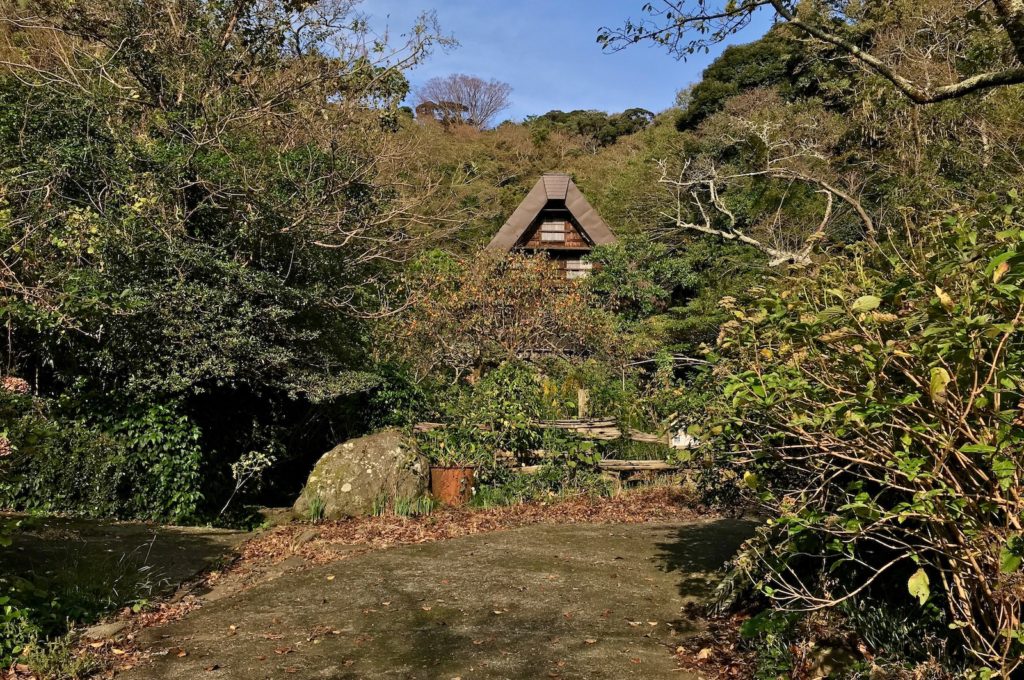
Ever since Shirakawa-go attained UNESCO World Heritage status, visitors have flocked there by the thousands to view the gassho-zukuri farmhouses. While they’re worth seeing, it’s also not the most convenient place to get to. If visiting one is a priority, you can actually see one without going all the way out to Shirakawa-go. Try visiting the sleepy coastal town of Shimoda on the Izu Peninsula instead! This is where you’ll find the Murakami Gassho-zukuri Folk Museum.
Life around the irori
Entering the Murakami Gassho-zukuri Folk Museum is like stepping in to another time. It’s dimly lit inside, the surfaces and shelves overflowing with all manner of paraphernalia from lacquer bowls to carvings to books to masks. You’ll see the irori, or open fireplace when you walk in looking for the caretaker. It’s distinctly smoky in here.
Murakami-san is the custodian of this house. If you ask, he may tell you how the house came to be here. His father wanted to live in a gassho-zukuri farmhouse such as this, and had one painstakingly transported to this part of Shimoda from a faraway village. Piece by piece, he reconstructed it exactly as it would have stood in those mountains.
“My father, he didn’t think about his children,” said Murakami-san with a wry smile. “My lungs are all messed up inside from the smoke.”
He can usually be found sitting in front of the irori, stoking the fire by blowing into a hollow bamboo stick. He occasionally runs his fingers through the flames—just to prove that it isn’t hot. I fear that he will burn himself, but he doesn’t.
He might pour you a cup of tea, and give you a homemade caramel to go along with it. You may feel obliged to accept this hospitable gesture and eat the caramel, even if you don’t like sweets that much. As you eat it you might realise that it is far too big to comfortably chew. Your next thirty minutes will be spent waiting for the caramel to dissolve in your mouth while you explore the house. Let’s hope you like caramel.
On the ground floor of the gassho-zukuri house
The folk museum is huge, to put it mildly—there are five floors to explore here. Begin by wandering around the large living space on the ground floor.
There’s a strange and eclectic assortment of items here: old hanging scrolls and samurai armour, stacks of cushions that look like they’ve been there for decades, fur stoles draped over room dividers, another open fireplace, clocks, sofas, armchairs, old radiators.
Why is there so much stuff lying around? These were apparently all donated by local residents who didn’t need these items anymore.
Climbing up to the upper storeys
The second floor has a distinctly lower ceiling. The staircase leading up seems rickety, but it’s sturdy enough to hold your weight.
Here, there’s an incredible assortment of farming equipment and miscellaneous apparatus for rural life. Straw coats, weaving looms, woven armchairs—it’s a fascinating glimpse into the kinds of work that would have been carried out in and around a traditional farmhouse like this.
At the top of the gassho-zukuri farmhouse
As you go further up, the ceiling seems to get progressively lower. You’ll have a marvelous view of the garden below at the top of the house—it is distinctly un-manicured, even a little feral-looking.
Don’t forget to have a close look at the fine workmanship of the thatched roof, and the ropes wound around the wooden beams. It’s really remarkable being able to see the gassho-zukuri style up close.
The folk museum is a real gem of a building. Even if it’s a little out of the way from the main tourist attractions in town, it’s worth the extra walk to see a place like this. As a bonus, Shimoda is very accessible from Tokyo.
How to get here
The folk museum is a 25-minute walk from Izukyu-Shimoda Station. Alternatively, take a bus to Perry Road. From here, it’s a 12-minute walk. It’s located near two hotels: Shimoda Kaihin Hotel, and Shimoda Tokyo Hotel.
Name: Murakami Gasshou Zukuri Mingeikan
Address: 3-26-27, Oura, Shimoda-shi, Shizuoka
Open: 9:00am–4:00pm (varies by season)
Website: www.gasshou.com
Post by Japan Journeys.